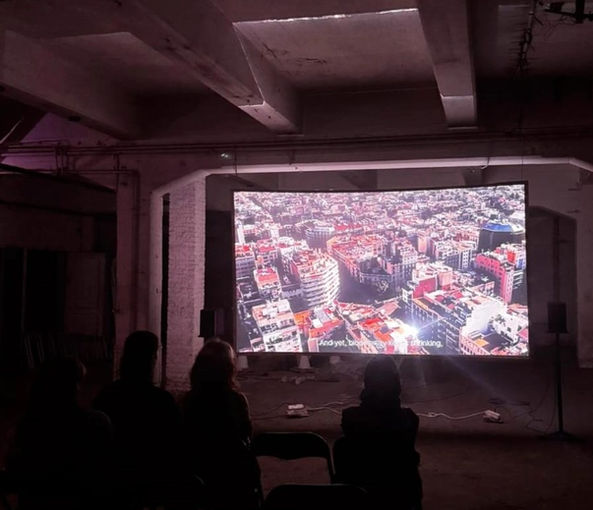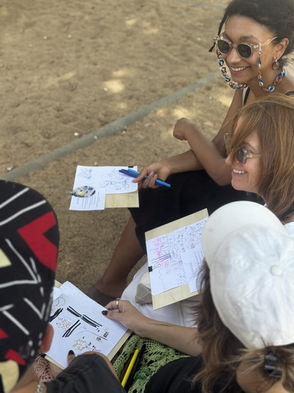Alternative Presents
Present Continuities
Habitants* of Barcelona like myself, live in the city with unequal access to (healthy) living space, in a model that favors some and ignores others—a city where habitants compete with each other instead of collaborating.
Alternative Presents
Habitants* of Barcelona like myself, live in the city with equal access to space, thanks to new urban models that take into account both humans and non-humans. Competition has been replaced by collaboration and care, with learning from other species to improve the quality of life for all.
*habitants understood as all species, humans and non-humans
Reflecting on the Alternative Presents I’m Creating
Alternative Presents I'm creating now: Habitants* from different cities are beginning to see alternative urban models that take into account both humans and non-humans. Competition is being replaced by collaboration and care, with learning from other species to improve the quality of life for all. In case of alternative presents I’m creating, a large part of them still remains in the realm of knowledge and imagination, held together by empathy, care, and responsibility. What is still missing are tangible practices and tools FOR/WITH others IN Barcelona. Over the past weeks, I’ve been sharing my explorations more globally, staying under a broader umbrella of my explorations, even though my practical experiments have been grounded in a local context. I believe that in this last term, it will be important for me to connect these two layers — to find a way not to lose the narrative and imaginative dimension, but to enrich it with a concrete tool/practice/workshop tested specifically in Barcelona. Something I can continue to build on — more situated, but with the potential to be adapted in other contexts.
Ways of Drifting
In the context of Ways of Drifting, I think primarily I followed an expansive trajectory—broadening and extending the scope of interests across disciplines, scales and just small lines of thoughts. My design space became a dynamic ecosystem for exploring interspecies collaboration, ecological regeneration, empathy and urban reimagination through various interventions and perspectives. Within this expansive drift, there were also moments of serial exploration—more systematic, specifically related to experimenting with slime mold. These serial interventions provided grounded insights that fed back into the broader, more speculative narrative of my explorations, creating a layered interplay between the situated and the systemic (as I feel it).
Roadmap
Scalability roadmap & envision the future of my practice: download file.
Storytelling
Storytelling of my project: download file.
(and narrative for visual essay)
MDEFest
activation
Towards final activation
The last term was an incredibly intense ride for me—a time of deep learning, exchanging perspectives, and powerful inspiration, happening both at IAAC and outside the program. I’m incredibly grateful for the range of opportunities that came my way and enriched my final project in meaningful ways. From Future Days and the labs I participated in—focused on symbiotic futures and the power of collective imagination—to the Urban Future Young Leaders Program, which offered practical skills and further inspiration for my final thesis project. Additionally, The Slime Knows exhibition brought a refreshing artistic energy and a more poetic lens to the interpretation of slime intelligence. Each experience left a lasting impact. All these moments helped shape and inspire my final contribution during MDEFest – the Interspecies City Workshop, held as part of poly:eutopia.
Interspecies Cities Workshop
My proposal for MDEFest was the Interspecies City Workshop—a guided urban walk combined with relational mapping from a non-human perspective. At the heart of the experience was a living artifact: a petri dish containing Physarum polycephalum, growing on a 3D-printed urban model of Barcelona. This living organism served as a symbolic and biological framework for layering the relational maps created by participants during the walk. The workshop development continued through weeks of iterative prototyping, which included on-site visits, different form testing (If general mapping, or for specific species, or for specific sphere), timing tests, and area checking around Tres Xemeneies to ensure the route and experience were coherent and engaging. I carefully designed and prepared individual kits for each participant, I worked on preparing the necessary logistics (like design of google form, welcome & reminder emails, and planning communication flows—to ensure each participant felt welcomed and informed.
For the workshop, I initially planned 8 to 12 participants, based on a framework that divided the mapping activity into four sensing spheres: aquasphere, aerosphere, biosphere, and geosphere. I eventually gathered a group of 10 people, but due to last-minute changes, 8 participants joined—perfectly forming 4 pairs, one for each sphere.
The walk began with a welcome and a short introduction to my project, followed by an explanation of the workshop flow. We then set off on a slow, attentive walk, stepping into the roles of non-human detectives, searching for subtle signals of life, presence, and interaction within the urban ecosystem. The workshop concluded with a collective reflection—first through a short exercise in two smaller groups (where participants explored the interdependencies and relational dynamics between their assigned spheres), and then with an open ending discussion all together. It was a powerful moment of shared insights and curiosity. For me, this activation became a meaningful starting point for further exploration and analysis. It was also a valuable personal learning experience, helping me grow more confident in public speaking and facilitation.
We wrapped up the session and walked back to MDEFest for the closing party—a perfect ending to an intense and inspiring journey. A huge thank you to the participants—Akira, Christina, Isabela, Lars, Maciej, Maja, Mathilde, and Ziming—for being the starting point in the co-creation of poly:eutopia (which is not utopian vision, but design practice—empathetic, interdependent, and symbiotic).


































